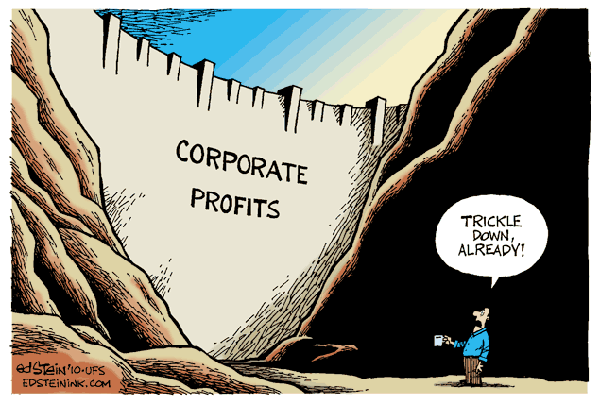GMO‘s Jeremy Grantham is worried about the perseverance of abnormally high corporate profit margins in the US. The phenomenon is amongst other things upsetting the standard notion that profits are mean reverting to historic averages. But as the following chart from GMO’s latest quarterly letter shows this just isn’t happening:

Grantham suspects historically low rates since 1997 combined with higher leverage play a big part in the story. Even so, it can’t be the only explainer. As Grantham says, in a world of reasonable competitiveness higher margins from long-term lower rates should have been competed away. Since they have not, the anomaly must be down to something else.
Grantham puts the cause down to three other factors: Increased monopoly power, increased political power and increased brand power.
The general pattern described so far is entirely compatible with increased monopoly power for US corporations. Put this way, if they had materially more monopoly power, we would expect to see exactly what we do see: higher profit margins; increased reluctance to expand capacity; slight reductions in GDP growth and productivity; pressure on wages, unions, and labor negotiations; and fewer new entrants into the corporate world and a declining number of increasingly large corporations. And because these factors affect the US more than other developed countries, US margins should be higher than theirs. It is a global system and we out-brand them for one thing.
Interestingly, Grantham links the increase in corporate power over the last 40 years to a somewhat counterintuitive factor: The increasingly weighty regulatory environment which counterintuitively ends up benefitting the larger and more politically savvy corporations. These large corporations, he says, can use their incumbent clout and income streams to navigate and manage the regulatory burden. Smaller companies can’t, hence there’s been a steady drop of net new entrants into the US business world since 1970:

Mo regulation, mo money for corps
Put another way, these regulations — even if created for the public benefit — end up having an anti-competitive effect. From Grantham:
They form a protective moat for large, established firms. This produces the irony that the current ripping out of regulations willy-nilly will of course reduce short-term corporate costs and increase profits in the near future (other things being equal), but for the longer run, the corporate establishment’s enthusiasm for less regulation is misguided: Stripping out regulations is working to fill in its protective moat.
If Grantham is right, investors should start asking what — if anything — can nip this phenomenon in the bud. Grantham indicates higher rates may do the trick. Problem is, those are unlikely to come about any time soon. Until they do, it’s likely abnormally high corporate profit margins will remain a thing or even intensify. As Grantham notes:
In the meantime, while we wait for higher risk-free rates, investors – value mangers included – should brace themselves for continued higher multiples than those of the old days. (Although with a very good chance that multiples will show a very slow decline.)
From a value investor’s point of view, Grantham cautions:
…if you are expecting a quick or explosive market decline in the S&P 500 that will return us to pre-1997 ratios (perhaps because that is the kind of thing that happened in the past), then you should at least be prepared to be frustrated for some considerable further time: until you can feel the process of the real interest rate structure moving back up toward its old level. All in all, from the many possibilities, I prefer my suggestion (from Part 1) of a 20-year limping regression that takes us two-thirds of the way back to the good old days pre-1997. What I fear is that if I am wrong, it is less likely to be because regression is more dramatic as some die-hard value managers believe (and I would dearly, dearly love to see!) than it is to be even slower. (The outlook I proposed for the S&P 500 last October of 2.8% real per year for 20 years – the whimper path – has fallen to 2.3% real at recent higher prices).
Two things investors can expect in 2017, nevertheless, is that if Trump achieves a moderate reduction in corporate tax rates this year, the monopolistic structure of the market will see this translate into even higher corporate profits rather than a boon to consumers. Meanwhile, if Trump manages to remove regulations here and there, this too will translate to lower corporate costs in the short term (even if in the longer run it will upend the corporate monopoly structure). Net-net corporate profit margins will keep going up this year.
As for a permanent reversion to the pre-1997 trend, Grantham suspects we will have to wait even longer for that than any value manager (such as himself) would like.

